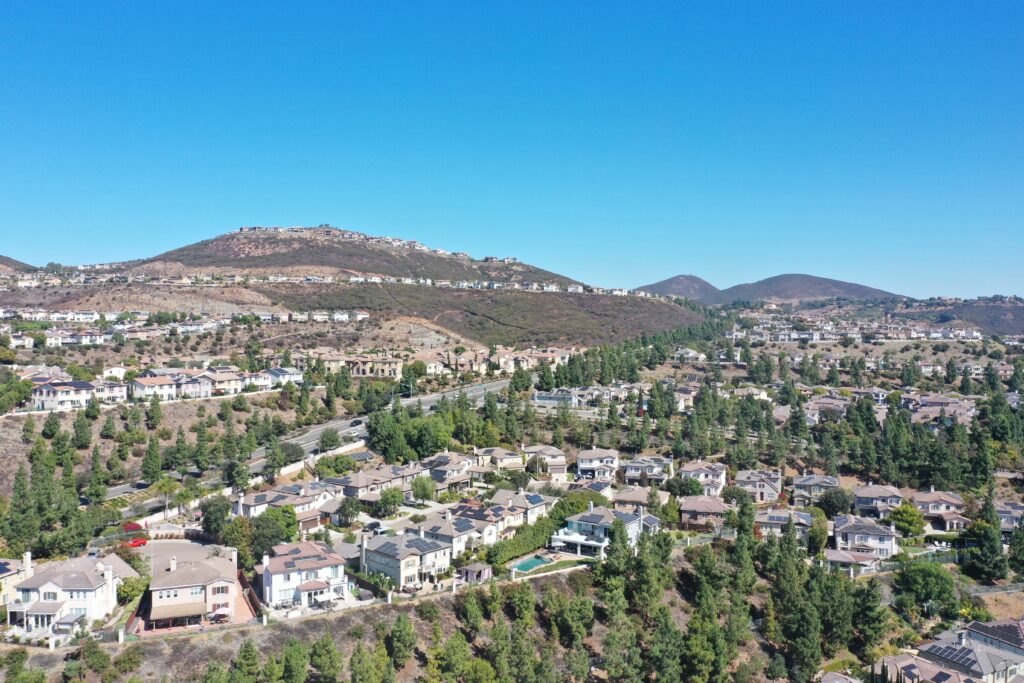
San Elijo Hills: Built to Belong — Honoring the Original Vision
As new families move in and design trends evolve, it’s easy to get caught up in what’s current. But San Elijo Hills was never meant to be trendy. It was meant to be timeless. Thoughtfully carved into the coastal hills of North County, this community was designed with intention—from the color on the walls to the curve of the trail.
At the heart of that vision? A deep respect for the land.
From the beginning, HomeFed Corporation set out to create more than a development. Led by visionary planner Kurt Noland—who had previously shaped the resort-style community of Aviara—the team aimed to build a place that felt rooted. Not just in geography, but in purpose.
Double Peak at Sunset: A Living Reminder
Stand on Double Peak at sunset, and you’ll feel it. The rolling hills bathed in golden light, the homes nestled quietly below, and the ocean shimmering on the horizon—it all fits. The colors, the textures, the layout. There’s a natural rhythm here. It’s not loud. It’s not forced. It just belongs best it can in the natural hills.
That view reminds us of what this place is really about: connection. To the land, to the light, to each other.
Built to Blend In, Not Stand Out
San Elijo Hills was designed to harmonize with its environment, not dominate it. That’s why the community didn’t default to lush tropical landscaping or flashy color schemes. Instead, it leaned into the soft earth tones and native chaparral that already existed here.
The plant palette focused on drought-tolerant California natives—sages, manzanita, buckwheat, California lilac—chosen for their resilience and ability to support local pollinators and wildlife. The goal was simple: reduce water use, match the landscape, and create something that feels right with the seasons.
Homes were painted in warm neutrals—sunbaked taupe, olive green trim, terracotta roofs—colors pulled directly from the surrounding hills and canyons. These homes don’t compete with the view—they let the land take the lead.
Wood Rail Fencing vs. Plastic and Metal
That same thoughtful design shows up in the details, too—like the fencing.
Throughout San Elijo Hills, you’ll still find rustic split-rail wood fencing lining trails and greenbelts. It’s a small design choice with a big impact. The weathered wood blends into the chaparral. It’s authentic. Textural. Grounded.
Compare that to shiny plastic or metal fencing, which often feels out of place here—too clean, too sterile, too suburban. The original team didn’t want something that screamed “new.” They wanted something that felt natural. The kind of fence you’d expect to find bordering an old ranch trail or a quiet overlook.
It’s those choices—the ones that don’t always scream for attention—that quietly define the character of San Elijo Hills.
Chaparral, Fire, and Evolving Realities
San Elijo Hills was designed to reflect the beauty and resilience of the native chaparral landscape—but today, that same chaparral is under new pressure. With growing wildfire risks across Southern California, we’re being forced to reexamine what it means to build with nature.
The original landscape plan prioritized water-wise, regionally appropriate planting—but even native plants like chaparral and sagebrush are fire-adaptive species. As fire season stretches longer and burns hotter, that once-celebrated authenticity is now part of a bigger conversation about resilience.
Some choices, in hindsight, may need a second look. Pines, for example, were planted in parts of the community as a nod to mountain or park-like aesthetics. But with their heavy needle drop and high flammability, they may have introduced more risk than benefit. And as blasting and grading shaped home pads into the hillsides, more trees were added—sometimes crowding terrain that historically remained open.
This isn’t about blaming past choices. It’s about evolving responsibly. Great design should adapt—and the legacy of San Elijo Hills gives us the foundation to do just that.
Community Design with Intention
From the placement of parks to the layout of the town center, every decision was made with environmental design and lifestyle in mind. Winding streets follow the terrain. Trails connect neighborhoods. Schools and businesses anchor the heart of town.
This is community planning as a long-term investment—not just in property values, but in quality of life.
Fads Will Pass. Good Design Lasts.
Today, we see the pressure to modernize. Cooler colors. Sleek hardscaping. Tropical plants. And while change can be good, it’s important to ask: Does this still feel like San Elijo Hills?
Because this community was never built to chase fashion. It was built to endure.
The original vision still matters—Kurt Noland and the HomeFed team designed this place to reflect its environment, support its residents, and age gracefully with the land. And that vision is just as relevant today.
Built to blend. Designed to endure. Rooted in the hills we call home.
Let’s remember what made this place special. Let’s keep San Elijo Hills… San Elijo Hills.
Built to blend. Designed to endure. Rooted in the hills we call home.
Let’s remember what made this place special. Let’s keep San Elijo Hills… San Elijo Hills.
See you on the trails.
Ed Philbrick-22 year resident of San Elijo Hills and Realtor and publisher of San Elijo Life.







